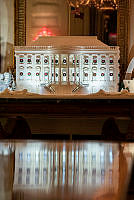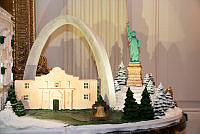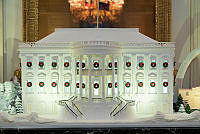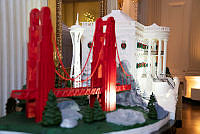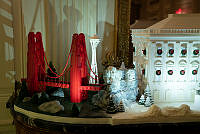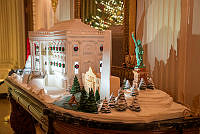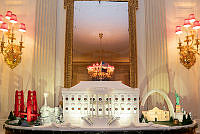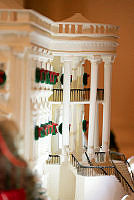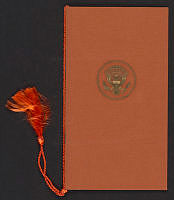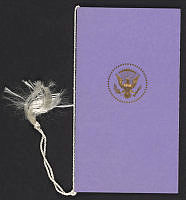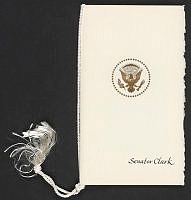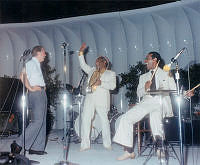Rubenstein Center Scholarship
"He Stands for All the Fallen"
World War I and the Death of Quentin Roosevelt
“Quentin’s mother and I are very glad that he got to the front and had the chance to render some service to his country and to show the stuff there was in him before his fate befell him” – Former President Theodore Roosevelt, July 17, 19181
On July 14th, 1918, less than four months before the end of World War I, Lieutenant Quentin Roosevelt’s plane was shot down behind German lines near Chamery, France. President Theodore Roosevelt’s youngest son had been a media favorite since his childhood in the White House, and Americans waited anxiously for news of his fate. Some held out hope that he had made a successful emergency landing and ended up as a prisoner of war.2 Several days later, the worst was confirmed. At only twenty years old, Quentin Roosevelt was dead.
Much of the public remembrance of Quentin in the days that followed reminisced about his boyhood in the White House. Quentin was three years old when his father assumed the presidency after the assassination of William McKinley. He quickly became infamous for his adventures with the “White House Gang,” a group of boys that included his brother Archibald (Archie) and their friends from the Force School. The gang’s exploits ranged from carving a baseball diamond on the White House lawn to allegedly shooting spitballs at President Andrew Jackson’s portrait.3 The Roosevelt boys’ pony, Algonquin, was often featured in their stories as well. In one famous incident, Archie was sick in bed and Quentin coaxed the pony onto the White House elevator and up to Archie’s sickroom to cheer him up.4

Four-year-old Quentin riding Algonquin the pony near the White House.
Library of CongressWhen the United States officially entered World War I in 1917, Quentin’s wild White House days were long past. He was attending his father’s alma mater, Harvard.5 Theodore Roosevelt had been a major advocate of American involvement in the war, so naturally Quentin left school and accepted a commission, as did all three of his brothers: Archie, Kermit, and Theodore Jr. Of the four, only Quentin chose to train as a pilot. He had a bad back and poor eyesight, which should have disqualified him from flying, but managed to bypass this issue by memorizing the letters on the eye exam.6 By July of 1917, he was on his way to the American flying school at Issoudun in France. Quentin was a grown man going off to war, but he was still thought of as the baby of the family. According to one of his father’s letters, on his last night at the Roosevelt home at Sagamore Hill, his mother tucked him into bed.7
Theodore Roosevelt and his wife Edith both worried for their sons but celebrated their decision to fight for their country. The former president had been an early supporter of American interventionism in Europe and had in fact tried to convince President Woodrow Wilson to let him go to the front himself. Instead, as he said in a speech in late 1917, “I have sent my four sons. I have sent over my four boys, for each of whose lives I care a thousand times more than I care for my own.”8

Quentin in uniform.
National Museum of the U.S. Air ForceIn France, Quentin quickly became frustrated with the slow pace of moving from the training ground to the front. The United States was faced with the enormous task of mobilizing a large force out of its previously small military, and the U.S. Air Service did not have enough planes available for all its new pilots. When Quentin finished his course of training at Issoudun, there was nothing for him to do but stay there, serving as quartermaster and supervising the mechanics.9
It was June 1918, nearly a year after he had arrived, that Quentin received his orders for combat flight. “I’m on the front – cheers, oh cheers – and I’m very happy,” he wrote to his family on June 25th.10 Combat missions in those early days of aerial warfare were incredibly dangerous, and the average pilot’s life expectancy could be a matter of weeks once in active service.11 Quentin, while a competent pilot, was no experienced ace, and he did not play it safe. Men who knew him described his “daring” and “aggressive spirit.”12
In early July, Quentin engaged in his first dogfight. A week later, he brought down his first and only German airplane, a success that was touted by many American newspapers. The nearsightedness he had hidden to get accepted as a pilot may have come into play in that kill, as Lieutenant Roosevelt saw three planes he thought were American and started to join them in formation, only to realize they were actually German planes. He successfully shot down one and evaded the other two.13 Four days after that success, Quentin was drawn into another dogfight, the details of which are hard to pin down given the exaggerated stories that emerged later. What is clear is how it ended: Quentin Roosevelt was shot twice and his plane crashed in the French countryside.

Quentin was flying a Nieuport 28 like this one, painted with the donkey insignia of his 95th Aero Squadron, when he was shot down.
Air Service, United States ArmyWhen a German press release confirmed the news of Quentin’s passing, condolences poured in to Sagamore Hill. President Wilson, who had been Theodore Roosevelt’s bitter rival in the 1912 election, telegrammed to say, “Am greatly distressed that the news of your son’s death is confirmed. I had hoped for other news. He died serving his country and died with fine gallantry. I am deeply grieved that his service should have come to this tragic end.”14 General John J. Pershing sent his sympathies as well.15 Members of the public, family friends, and men who had served with Quentin added to the throng of mourners. Many of his comrades emphasized that Quentin had been “especially loved by the enlisted men,” not just by his fellow officers.16 The Roosevelts made a single, brief public statement and then largely retreated from the spotlight in the weeks following the loss of their son.
For the rest of the country, Quentin became a figure for national mourning. He was the highest-profile American casualty of the war. American airfields, a French naval ship, and even a town in Pennsylvania were named after him. Poems and requiems filled newspapers across the country.17 So did editorials, which eulogized Quentin in highly emotional language. “We think of gallant, modest Quentin as typical of all Americans, as the flower and fruit of the patriotism a lax generation first awoke to at his father’s call…he stands for all the fallen upon whom no public glory falls,” read one column from Reedy’s Mirror in St. Louis.18 The youngest Roosevelt’s demise came to symbolize all of America’s contribution to the war.
Many of the editorials, including one by the rector of Quentin’s old school, observed that while a powerful former American president was willing to put his sons in harm’s way, the German Kaiser Wilhelm II’s six sons were assigned to positions well behind the front line. While Quentin was killed, and Theodore Jr. and Archie sustained significant wounds during the war, the sons of the German leader remained relatively safe.19 Apparently that irony was not lost on the German soldiers either. German authorities circulated a gruesome photo of Quentin’s body next to his wrecked plane, hoping to inspire confidence in the ranks, but the move backfired. Many soldiers were instead impressed that one of America’s most powerful families sent their own sons into battle and were aggrieved that their own leaders did not do the same.20

Quentin’s grave near Chamery, 1918. The railing and headstone added by the French are visible in this photo, along with a cross placed by American troops when they first retook Chamery. The marble slab and American Legion marker would be added the following year.
Library of CongressQuentin was buried with full military honors near the spot where he fell, by the German airmen who first recovered his body.21 When the war ended, many American families chose to have the bodies of loved ones repatriated to the United States, but Theodore Roosevelt decided against it. “We feel that where the tree falls, there let it lie,” he wrote.22 Officially, the remains of American soldiers buried in France were supposed to be removed to national cemeteries, but the family of a former president easily got an exception, so Quentin remained buried a few yards from where his plane went down. His grave became a pilgrimage site, evolving over the years from the simple wooden cross that the German soldiers erected to a more ornate memorial. The French government put up a headstone and a decorative wooden fence around the grave. The Roosevelt family added a marble slab, and a post of the newly-formed American Legion contributed a bronze marker next to Quentin’s grave.23
Several mementos made their way home to the Roosevelt family. The twisted axle of Quentin’s Nieuport plane, retrieved from the front, hung in a place of honor at Sagamore Hill for decades. More gruesomely, the family was also sent the German propaganda photo of Quentin’s body next to his plane. The photo was undoubtedly intended to horrify and upset the Roosevelts, but instead became a treasured reminder of Quentin’s heroism and ended up in family scrapbooks.24
Mementos and monuments helped ease the family’s suffering, but all recognized the war and especially Quentin’s death as a turning point in their lives. The former president, in particular, was never quite the same again. “To feel one has inspired a boy to conduct that has resulted in his death, has a pretty serious side for a father,” Theodore Roosevelt wrote, perhaps reflecting on his promotion of American military intervention and his celebration of military glory.25 One contemporary newspaper reported him making frequent visits to the stable to pet Algonquin, the now-elderly pony who had once been an accomplice in Quentin’s boyhood pranks.26 The elder Roosevelt’s health began to decline in the wake of his son’s death, and less than six months after Quentin he passed away in his sleep.
As the decades passed, Quentin’s gravesite near Chamery began to deteriorate. The oak fencing erected by the French was not built to last forever, and it ultimately fell into disrepair. American visitors mostly stopped making the pilgrimage to the site, although the Paris American Legion post continued to hold a wreath-laying ceremony there every Memorial Day.27 Then a second World War came and went, and another Roosevelt son lay buried in France. Theodore Roosevelt Jr., at 56, had been the oldest American to invade Normandy on D-Day, joining his son, Captain Quentin Roosevelt II.28 After the invasion he succumbed to a heart attack and was buried at the American cemetery at Colleville-sur-Mer. The family decided that the best solution to the sorry state of Quentin’s grave was to have his body exhumed and reburied with his brother. After some bureaucratic wrangling to gain approval for this unorthodox transfer, Quentin’s remains were moved in September 1955.29 The crumbling, multi-layered monument in the field at Chamery was abandoned, and the brothers now lie side-by-side in a field of identical white crosses.














